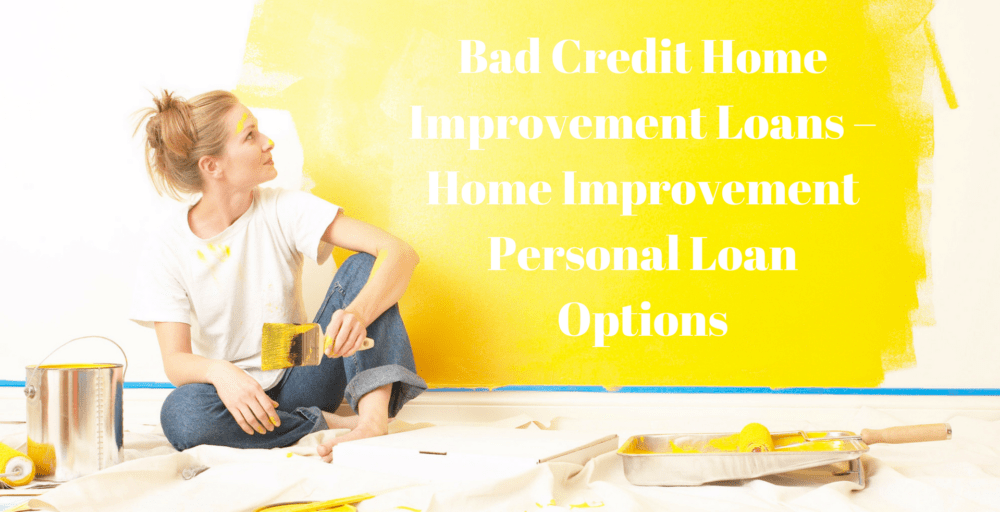Advertisement
home improvement loan poor credit – home improvement loans for poor credit can be a lifeline for homeowners who want to upgrade their living spaces but face challenges due to a less-than-perfect credit history. Navigating this process requires understanding the intricacies of loan types, lender considerations, and strategies for improving creditworthiness. This guide explores the options available, the obstacles you might encounter, and the steps you can take to secure a home improvement loan even with a lower credit score.
From exploring different loan types like personal loans, home equity loans, and credit lines to understanding the importance of comparing interest rates and terms, this comprehensive guide provides valuable insights into securing the necessary financing for your home improvement project.
Understanding Home Improvement Loans
 home improvement loan poor credit” title=”Loans loan” />
home improvement loan poor credit” title=”Loans loan” />
Home improvement loans are a popular financing option for homeowners who want to renovate, upgrade, or make repairs to their property. These loans can help you cover the costs of various projects, from simple cosmetic changes to major structural renovations.
Types of Home Improvement Loans
There are several types of home improvement loans available, each with its own terms and conditions. Understanding the different options can help you choose the loan that best suits your needs and financial situation.
- home equity loans: These loans are secured by your home’s equity, which is the difference between your home’s market value and the amount you owe on your mortgage. Home equity loans offer fixed interest rates and a fixed repayment term, making them predictable and reliable. They typically have lower interest rates than unsecured loans, but you risk losing your home if you default on the loan.
- Home Equity Lines of Credit (HELOCs): HELOCs are revolving lines of credit secured by your home’s equity. They allow you to borrow money as needed, up to a certain limit, and pay it back over time. HELOCs usually have variable interest rates that can fluctuate with market conditions. This can make it difficult to budget for repayments, but they can offer flexibility for ongoing projects or unexpected expenses.
- Personal Loans: These are unsecured loans that are not backed by any collateral. They are typically easier to qualify for than secured loans, but they often have higher interest rates. Personal loans are a good option for smaller home improvement projects, especially if you need funds quickly. However, they may not be suitable for larger projects due to the higher interest rates and shorter repayment terms.
- Cash-Out Refinancing: This option involves refinancing your existing mortgage to a higher amount and receiving the difference in cash. You can then use this cash for home improvements. Cash-out refinancing can be a good option if you have built up significant equity in your home and need a larger amount of money. However, it’s important to carefully consider the potential impact on your monthly mortgage payments and overall borrowing costs.
- FHA 203(k) Loans: These government-insured loans are specifically designed for home renovations and repairs. They allow you to finance both the purchase of a home and the cost of renovations, making them ideal for fixer-upper properties. FHA 203(k) loans offer flexible terms and lower interest rates, but they may have more stringent eligibility requirements and involve additional paperwork.
Common Features of Home Improvement Loans
Regardless of the type of home improvement loan you choose, there are some common features you can expect:
- Interest Rates: Interest rates vary depending on the loan type, your credit score, and the lender’s current rates. Lower interest rates can save you money in the long run.
- Loan Terms: The repayment term for a home improvement loan can range from a few years to 30 years. A shorter term generally means higher monthly payments but lower overall interest costs.
- Loan Fees: Lenders may charge various fees associated with home improvement loans, such as origination fees, appraisal fees, and closing costs. It’s important to understand all the fees involved before you commit to a loan.
- Loan Limits: Most lenders have limits on the amount you can borrow for home improvements. The maximum loan amount typically depends on your home’s value and your creditworthiness.
- Loan Requirements: To qualify for a home improvement loan, you will generally need to meet certain requirements, such as a minimum credit score, a stable income, and a debt-to-income ratio that falls within the lender’s guidelines.
Advantages and Disadvantages of Home Improvement Loans
Each type of home improvement loan has its own advantages and disadvantages. Carefully weighing these factors can help you determine which loan is right for you.
- home equity Loans and HELOCs:
- Advantages: Lower interest rates compared to unsecured loans, fixed interest rates (for home equity loans), flexibility (for HELOCs).
- Disadvantages: Risk of losing your home if you default, potential for higher interest rates than other secured loans, limited borrowing capacity.
- Personal Loans:
- Advantages: Easier to qualify for than secured loans, quick access to funds.
- Disadvantages: Higher interest rates than secured loans, shorter repayment terms.
- Cash-Out refinancing:
- Advantages: Access to a large amount of cash, potential for lower monthly payments if you qualify for a lower interest rate.
- Disadvantages: Increased borrowing costs, potential for higher monthly payments if you choose a longer repayment term.
- FHA 203(k) Loans:
- Advantages: Flexible terms, lower interest rates, government insurance.
- Disadvantages: More stringent eligibility requirements, additional paperwork.
Home Improvement Loans for Poor Credit
Securing a home improvement loan with poor credit can be challenging, but it’s not impossible. Lenders are often hesitant to extend credit to borrowers with a history of financial instability, as they perceive a higher risk of default. However, understanding the factors lenders consider and exploring alternative lending options can help you navigate this process.
Factors Lenders Consider When Evaluating Creditworthiness
Lenders evaluate various factors to assess your creditworthiness, including:
- Credit Score: This is a numerical representation of your credit history, reflecting your ability to manage debt responsibly. A lower credit score signals a higher risk to lenders.
- Credit History: Lenders analyze your credit report, which details your payment history, outstanding debts, and credit inquiries. A history of late payments, defaults, or bankruptcies can negatively impact your creditworthiness.
- Debt-to-Income Ratio (DTI): This ratio compares your monthly debt payments to your gross monthly income. A higher DTI indicates a greater financial burden, potentially making lenders less likely to approve a loan.
- Income and Employment History: Lenders want to ensure you have a stable income to repay the loan. They may review your income documentation and employment history to assess your financial stability.
- Loan Amount and Purpose: Lenders consider the loan amount and its intended use. A large loan amount or a loan for a risky project might be harder to secure.
Lenders Specializing in Loans for Borrowers with Less-Than-Perfect Credit
While traditional banks and credit unions may be less receptive to borrowers with poor credit, several lenders specialize in providing loans to individuals with less-than-perfect credit. These lenders often have higher interest rates and fees to compensate for the increased risk, but they offer a viable option for those who need access to financing.
- Online Lenders: Many online lenders specialize in providing loans to borrowers with poor credit. They often have more flexible lending criteria and faster approval processes. However, it’s crucial to compare interest rates, fees, and terms before committing to a loan.
- Credit Unions: Some credit unions offer loan programs designed for borrowers with poor credit. They may have more lenient requirements and potentially lower interest rates than traditional banks.
- Home Improvement Loans with Bad Credit: Specific lenders specialize in providing home improvement loans to borrowers with less-than-perfect credit. These lenders typically offer shorter loan terms and higher interest rates, but they can be a valuable option for those who need to finance necessary repairs or renovations.
Improving Your Credit Score: Home Improvement Loan Poor Credit

Your credit score is a crucial factor in determining your eligibility for a home improvement loan and the interest rate you’ll receive. A higher credit score signifies a lower risk to lenders, resulting in better loan terms.
Strategies for Improving Your Credit Score
Improving your credit score takes time and effort, but the benefits are substantial. Here are some effective strategies to consider:
- Pay Your Bills On Time: This is the most significant factor in your credit score. Late payments negatively impact your score, so make timely payments a priority. Set reminders, automate payments, or use a budgeting app to stay on top of your bills.
- Reduce Your Credit Utilization Ratio: This ratio measures the amount of credit you’re using compared to your available credit. Aim to keep your credit utilization ratio below 30%. Lowering your credit card balances or increasing your credit limits can improve this ratio.
- Avoid Opening New Credit Accounts: Opening too many new accounts can negatively affect your score, especially if you’re already struggling with debt. Focus on managing existing accounts responsibly.
- Become an Authorized User on a Credit Card With Good History: If you have a trusted friend or family member with a strong credit history, ask if you can be added as an authorized user on their credit card. This can help improve your credit score over time.
- Dispute Errors on Your Credit Report: Check your credit report for errors and inaccuracies. If you find any, file a dispute with the credit bureaus to have them corrected.
- Consider a Secured Credit Card: If you have limited credit history, a secured credit card can help build your score. These cards require a security deposit, which is used as collateral in case of non-payment.
Resources for Credit Score Improvement, Home improvement loan poor credit
Several resources can help you monitor and improve your credit score.
- Credit Bureaus: The three major credit bureaus – Equifax, Experian, and TransUnion – provide free annual credit reports. You can access them through AnnualCreditReport.com.
- Credit Monitoring Services: Credit monitoring services can alert you to changes in your credit report, such as new accounts or inquiries. Some services offer additional features like identity theft protection.
- Credit Counseling Agencies: Credit counseling agencies can provide personalized advice and support for improving your credit score and managing debt.
